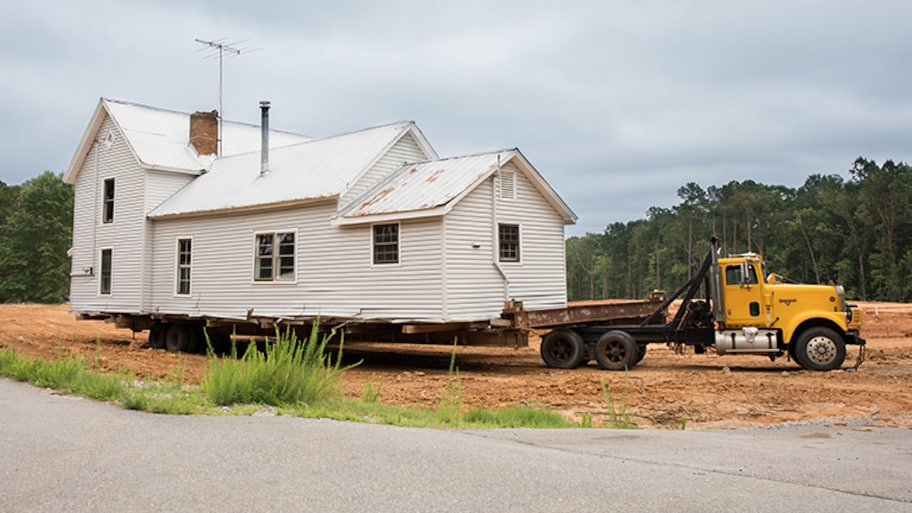How to Move a House: A Guide to Moving an Entire Home
Location, location, location—turns out, you can change that.


If you love your home but need to move across the country or got a deal on a house that can’t stay on its lot, you’ll need to learn how to move an entire home. But before you jump right in, it’s important to consult a structural moving company to decide if you can move the house to a different area. Let’s dive into how moving an entire house works and whether it suits your family’s needs.
Can You Move a House?
Yes, It’s possible to move a house to a new location, but there are several important factors that impact whether your home’s structural integrity, distance to travel, and final destination will align. It’s essential to consult local structural engineers and structural moving companies about the moving logistics to determine whether it’s a feasible option.
When You Can Move a House
You’re moving it a short distance, such as a different spot on the same lot or very close by.
The transportation route is clear and simple, including few overhead utility lines, limited trees, and minimal traffic.
The total moving costs are within your budget.
Your home is structurally sound enough to lift off of the foundation.
When You Can’t Move a House
You’re moving across the state or country.
The transportation route is full of trees, traffic, or overhead utility lines that can't be moved.
Your home has serious structural issues.
What’s a Structure Relocation?
Structure relocation is an engineering-related term for picking up a whole building and moving it to a different spot. You may see the phrase a lot when you contract with a professional that has experience in structural relocation. It’s very important to find professionals who are well-versed in this discipline, which requires close study of weight distribution, structural integrity, hydraulics, and more
Top Reasons People Move Their Houses
There aren’t many projects bigger than moving your whole house. Why do people do it? Several important reasons lead to this decision, including:
You live in a flood zone or other location that makes it very difficult to afford insurance, and want to move to a more affordable (and safer) region.
There’s a serious property line dispute and you want to avoid complex lawsuits by move your house to a different part of the property.
You purchased a house at auction but want to move it to a new property.
A huge zoning change means your house is now too close to a bridge or highway, and you want to move to a new lot.
Moisture, landslides, or erosion have damaged your foundation so much that your house needs to be moved to a different location.
Your land was acquired for a new purpose, such as a public works project, and you have arranged to save your home by moving it.
Ask Angi: How Can I Make Moving Stress-free?
6 Steps to Move a House
Moving a house requires lifting it from its foundation and setting it down in another location, sometimes from one state to another. Here are the steps for moving an entire house.
1. Plan the House Move
Upon hiring the moving company, you need to have some information handy like:
The blueprints of the building: Helps movers determine the structural support and material of the house.
The new location: Determines the cost and if it's feasible to move the house.
The moving plan: Includes info like whether you're taking additions like the garage or porch or brick chimney to the new location.
House moving professionals, including contractors, movers, and architects, will usually visit your home to decide if the house move is a sound decision and to calculate all the details and plan the move before starting the actual work.
2. Coordinate Permits and Paperwork
There are a few things you need to work on before the move. Luckily, a professional structural mover can help you handle all these things easily.
Obtain building permits for both old and new locations.
Hire an inspector to examine the structural integrity of the house.
Acquire road permits from the local departments for transporting the house.
Get the bank’s approval of the process.
3. Prepare the House

House moving requires intensive planning and coordination since most of the work happens in this step before the move. In this stage, movers, contractors, electricians, and plumbers work together to disconnect the house from the foundation, utilities, and infrastructure.
Your contractor will review the preparation steps as you schedule a timeline for the big move. Expect important steps such as:
Removing all items from your basement and crawl spaces.
Disconnecting and removing sections of plumbing and ductwork.
Removing important items from your home, including furniture, if possible.
Removing decks, steps, and other attachments to leave behind or transport later.
Schedule a full house cleaning ahead of the move.
Arrange for your off-site storage.
Schedule the pouring of your new foundation and utility hookups.
Attach wooden braces for support.
4. Lift the House
The structural moving company will dig down around the home’s foundation (or basement) and cut through to insert steel beams to jack up the structure.
A hydraulic jacking system elevates the house up to 12 feet evenly and steadily to support the building. Sliding beams are placed underneath the house to pull it onto dollies, which are then attached to the truck to transport the house to the new location.
5. Transport the House

According to the road plan, the truck will travel with the crew to get the house to the new location while factoring in obstructions, the width of the road, and power lines, etc. The trip can take several hours to several days, depending on the distance and any obstacles. Most houses are moved with furniture inside, with barely any damage. But the moving company takes on full liability in the event of damage to the house or its contents.
6. Integrate the Home at the New Location
The contractor will have the new foundation dug at the new site. When the home arrives, it will move with a ramp to the lot and will be jacked up until the contractor builds the new foundation. After that, the house is lowered to the new foundation.
The contractor will start reconnecting utilities by connecting to city sewer, water, and electricity lines. Finally, it's time to attach additions like the porch, garage, and mailbox, and finish everything up to make it home again.
3 Benefits of Moving Your House
While moving a home is no small feat, there can be some major benefits for you and your family.
Preserve a Historic Home
In some cases, a historic home may be in jeopardy of demolition if it’s not moved off of the current lot. One way to save a historical building and its dazzling architecture and details is to make plans to physically move it.
Keep a Sentimental House
If your house has been in your family for several generations, moving it to a new locale allows you to maintain it in a new space. If you've invested money and time customizing your home or making it handicap-accessible, you can save yourself from remodeling another home by taking the current one with you.
Move to a Better Location
Maybe you want less road noise or a different neighborhood or move to a property with more land. Or perhaps you need to move your home away from a flood zone or a receding shoreline. If there’s a reason you want to leave your current area, you can place your home in a better long-term location instead of finding and buying a new home.
3 Risks of Moving a House
Keep in mind that moving your entire home from one location to another carries a few risks. Review the risks carefully when deciding whether to move your home.
Unforeseen Costs
Despite careful planning and precautions, a project estimate is just an estimate. This type of large project can exceed an initial quote, especially if your team runs into unforeseen problems along the way. That’s why you should build some cushion into your budget to offset the unexpected costs of additional permits or moving expenses.
Possible Damage in Transit
As with any move, there’s a possibility that something could get broken during a house relocation. Moving an entire house heightens the risk for damage during transit, especially if you’re traveling several miles. Accidents can happen even with the most careful team, so be prepared to assess the house afterward for issues.
Inspections and Renovations
If you move your home to a new municipality, you may need to hire a local home inspector to assess the home after the move. In some cases, the house may need renovations to bring it up to code.
The Cost of Moving a House
Moving a house costs anywhere between $100,000 to $200,000. The price depends on factors like the size and the age of the house, the distance it travels, and any changes made in the new location. Contact local movers for a custom quote and to see if they handle structural moves like this.
In the end, you’ll also need to consider whether house moving makes financial and logistical sense for you and your family.
Labor
Labor costs can be hard to judge when relocating an entire house. Every structure offers a different layout, location, and approach. Often, the amount of labor needed isn’t entirely certain until the move has already begun. Your own unique estimate will provide a lot more information. However, for a general estimate, calculate around $14 per square foot of your house.
Weight
Homes can be made from many different materials. Fiber cement siding, for example, weighs a lot more than vinyl, and even changes like the width of the studs can contribute to weight. The heavier a home, the more difficult and costly it is to move it.
Size of the House
Small homes have a straightforward process for moving, unlike larger homes that may need to be cut into pieces, which adds to the price.
Height of the Building
If your home is taller than one story, it may get caught in utility wires on the road. The utility companies will have to raise the power lines, which mostly comes with an extra fee.
Distance and the Nature of the Route
Every town and city your house will travel through must grant a permit, which may require some legwork, and will cost more.
In some cases, if the path has many obstructions such as trees, mailboxes, curvy roads, or railroad crossings, then the cost will be even higher. In this case, the moving company will need to trim the trees, take care of traffic and power lines, and make arrangements along the way. It's typically easier to move houses within the same town, as a long-distance move can cost more and can get complicated. However, for some move-in areas, it's possible to go hundreds of miles without any obstacles other than dealing with different road regulations. Like each home, each move is unique.
Permits
Look up permits for moving a home early on. States and cities typically have very strict rules about when relocating a structure is allowed, and how much permits cost. Your state and local government website will offer specific info. Expected to pay between 10% and 30% of your moving costs for the permit alone.
Accommodations
The actual process of moving a house typically takes only a day or two. But there’s a lot of work before and after, which are vital parts of your budget. First, you’ll want to budget for the storage of your belongings while the house is relocated and connected to its new grid. Most professional movers will be able to store goods for a certain amount of time for you. Second, you’ll need to calculate the costs for your own accommodations (hotel, etc.) while you can’t use the house. Expect to spend about two months on average living outside of your home. You can cut costs a lot by finding a nearby relative to stay with.
Renovation Costs
If the new location requires your home to be up to a local building code, you might need to spend more on renovation after the move, things like replacing windows, or increasing insulation. Plus, you may need to repair or renovate any areas of the home damaged during transportation.
Tyler Lacoma contributed to this article.
Frequently Asked Questions
Building a house is generally more expensive upfront than moving an existing one. However, the total cost depends on factors such as location, size, materials, labor, and permits. Moving a house can incur significant expenses for transportation, permits, site preparation, and renovations. On the other hand, building a new house allows for customization and may have lower long-term maintenance costs.
The first step in moving a house is to provide blueprints and assess which parts of the house you can move. The next steps are obtaining permits, inspecting the structure, securing road permits, and getting bank approval.
When it's time to move, professionals can prepare the house by disconnecting utilities, removing items, and adding support braces. The house is then lifted with steel beams, jacked up, and placed on dollies for transport. Once it’s at the new location, it gets lowered onto the new foundation, utilities get reconnected, and additional features, like porches or garages, are added.
To begin the process of moving an entire house, start researching moving companies and contact several of them for quotes. Be sure to have your home’s blueprints handy, and provide key details like the distance of the move and whether you plan on moving any accessories. Once you’ve selected a mover, they can help you navigate the proper permits and paperwork to fill out, as well as prepare the home for the move.

